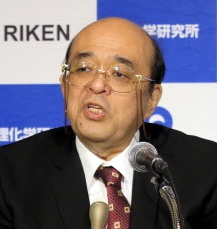Kōsuke Morita
From Wikipedia, the free encyclopedia
Kōsuke Morita (Japanese: 森田 浩介 Hepburn: Morita Kōsukee, born January 23, 1957) is a Japanese experimental nuclear physicist, known as the leader of the Japanese team that discovered nihonium (element 113). He currently holds a joint appointment as a professor at Kyushu University’s Graduate School of Science and as director of the Super Heavy Element Research Group at Riken's Nishina Center for Accelerator-Based Science.
Kōsuke Morita | |
|---|---|
 Kōsuke Morita, professor of the faculty of science, Kyushu University, attending the press conference for the official announcement of nihonium in Fukuoka City, Fukuoka Prefecture, on December 1, 2016 | |
| Born | January 23, 1957 Kitakyushu, Fukuoka, Japan |
| Nationality | Japanese |
| Alma mater | Kyushu University |
| Occupation | Experimental nuclear physicist |
| Employer(s) | Kyushu University; Riken |
| Known for | Discovery of element 113 |
Professional life
Summarize
Perspective
Kōsuke Morita is a Japanese physicist specializing in experimental nuclear physics. He was born in 1957 in the city of Kitakyushu (北九州), located in the prefecture of Fukuoka.[1] In 1979 he graduated from Kyushu University, where he would continue pursuing graduate studies. In 1984, he left Kyushu University after completing the doctoral program without receiving a degree.[2] In an interview, Morita was asked why he left without finishing his PhD thesis. He responded, “The reason was simple: I did not have the talent to finish it".[3] However, he returned to Kyushu University to complete his thesis in 1993, 9 years after beginning graduate studies.[3]
After leaving Kyushu University in 1984 Morita joined Riken as a postdoctoral researcher, later on becoming a junior research scientist at Riken's cyclotron Laboratory.[1][2][3] In 1991, he was promoted to research scientist and in 1993 to senior research scientist.[1][2] In 2006, he was appointed chief scientist of the Superheavy Element Laboratory at Riken's Nishina Center.[3]
Morita is currently a professor in the faculty of science at Kyushu University, where he has remained since his appointment in 2013. Additionally, he holds a position as the director of the Superheavy Element Production Team at Riken's Nishina Center for Accelerator-Based Science[1][4]
Research achievements
Summarize
Perspective

Synthesis of nihonium
Element 113 was first synthesized in 2004 by the Superheavy Element Production Team at Riken, under direction of Kōsuke Morita.[5] The element was synthesized using a cold fusion approach, making it the heaviest element discovered using this production method.[6] Synthesis of element 113 was accomplished by bombardment of a 209Bi target with 70Zn projectiles using a beam energy of 352.6 MeV.[5] The experiment concluded with the synthesis of the 278113 isotope of element 113.[5]
Morita's team successfully synthesized element 113 in a total of three occasions: July 2004, April 2005, and August 2012.[2][7][8] This achievement was officially recognized by the International Union of Pure and Applied Chemistry on December 31, 2015, granting Morita's team the element's naming rights.[7] The name Nihonium was proposed, making reference to Japan's name (Japanese: 日本 Hepburn: Nihon).[7] After a five-month public comment period, the union announced its formal approval on November 30, 2016.[9][10] Nihonium is currently the only element to have been discovered by an Asian team.[10][11]
The team currently aims to discover element 119, whose provisional name is ununennium.[12][13]
Work and education
- 1972 – Graduates from Beppu Municipal Central Junior High School (別府市中部中学校).[14]
- 1975 – Graduates from Beppu Tsurumi Hill High School (別府鶴見丘高等学校) in Oita prefecture (大分県立).[14]
- 1984 – Graduates from Kyushu University School of Physics.
- 1984 – Postdoctoral Researcher, Riken Cyclotron Laboratory.
- 1991 – Research Scientist, Riken Cyclotron Laboratory 1993 – Receives his PhD from Kyushu University.
- 1993 – Senior Research Scientist, Riken Cyclotron Laboratory 2004 – First synthesis of element 113 at Riken.
- 2006 – Chief Scientist and Director, Superheavy Element Laboratory, Nishina Center for Accelerator Research, Riken.
- 2013 – Professor, Kyushu University Graduate School of Science, Institute for Experimental Nuclear Physics
Awards
- 2005 – The GSI Exotic Nuclei Community Membership Award.
- 2005 – Nishina Memorial Prize (仁科記念賞).
- 2005 – Inoue Science Award (井上学術賞).
- 2006 – 11th Paper Award of the Physical Society of Japan (JPS) (Joint Award).
- 2012 – Nice Step Scientist (ナイスステップな科学者).
- 2016 – Japan Academy Prize ( 日本学士院賞).[15]
- 2017 - Asahi Prize (朝日賞).[16]
References
External links
Wikiwand - on
Seamless Wikipedia browsing. On steroids.
